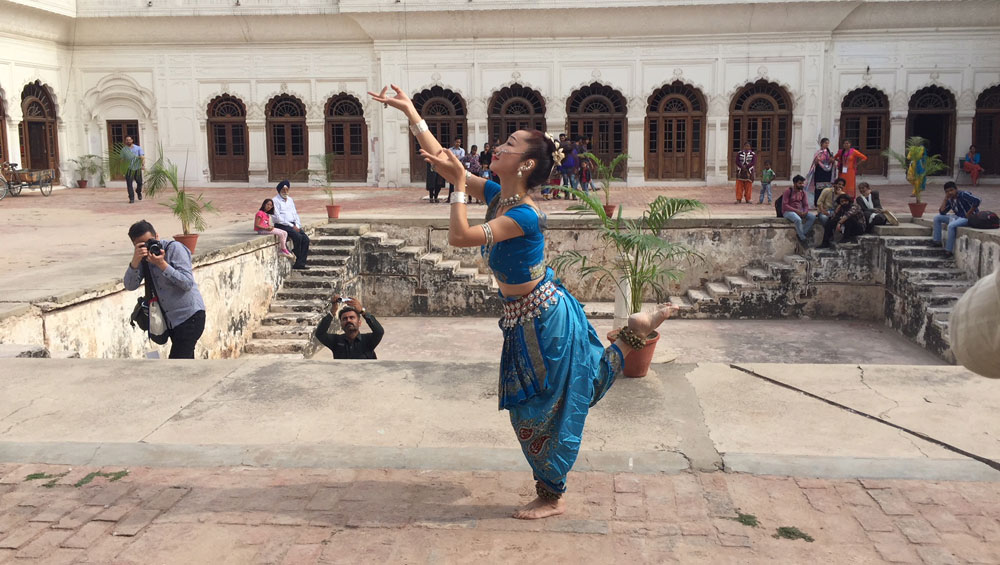
Qila Mubarak, Patiala, Punjab
3-4 March 2018
by JILL SPALDING
Punjab! For centuries, this great turban of Sikhism thrusting north to Kashmir was crisscrossed by warriors risking all for dominion. Its bloodiest battlefield, Patiala, arose more than 300 years ago when the great warrior Baba Ala Singh (titled Raja by the Afghan warlord he had beneficially served), carved out of a corridor fought over since the time of Alexander the Great a prosperous and glamorous princely state. Ruled over fiercely but judiciously, inter-clan rivalries, hybrid languages (notably Deccani and Urdu) and disparate faiths (Sikhism, Hinduism, Buddhism, Islam) coalesced into a well-governed region the size of Cyprus with an agrarian economy and political voice to be reckoned with.
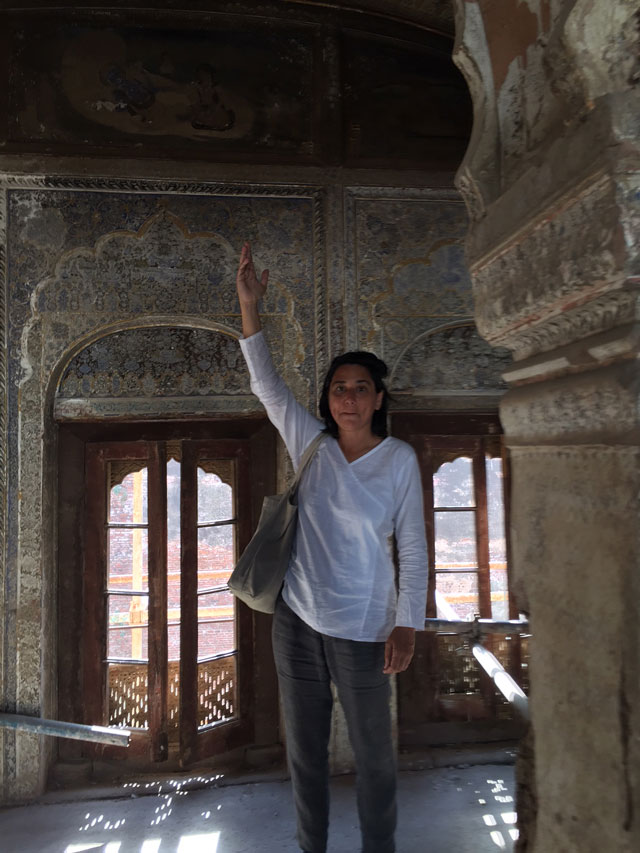
Sarah Singh in the Qila Mubarak palace-fort.
So matters stood until the Brits got a hold on any riches that could be extracted from all India, handing over in return a rule by absentee sovereign that retained respect for the maharajas, but gave power to the viceroys and replaced hierarchy with bureaucracy, regional dialects with English and long-honoured borders with politically driven realignments. The Raj, for purposes both political and social (King George and Queen Mary did love those bells and whistles receptions) was given long rein. The maharajas of Patiala, backed by personal fortune, profiled the region with staggering splendour. All you need to know about the legendary Bhupinder Singh – he of the famed necklace created by Cartier from his gemstones – is that he was the first Indian to possess a car and an aeroplane (the latter, the Wright Brothers’ Model-B) and owned its top polo and cricket teams.
Beneath the glory, nonetheless, the subcontinent was unravelling. Giving lie to what looked to the world like a cohesive, strong nation, the in-fact fragile construct, held together by the chauvinist rule of a foreign self-declared Empress, cracked under the arbitrary Partition of 1947 like a great Humpty Dumpty. Most grievously impacted by the sizable portion of land lost to the new nation of Pakistan, The Punjab, as it had been known in its glory days, surrendered not only its honorific, but the fertile region of Lahore with its verdant tiara, the famed Gardens of Shalimar, and the three rivers that fed it. Know that “Punjab” translates as five rivers and you will understand how the trauma of this amputation scarred the community’s viscera.
Sikh traditions, however, remain vibrant and deep-rooted. Class is still the divide, although its signifiers are subtle; there is, for example, no reserved colour of tunic, sari or the carefully pre-wrapped Sikh turban to distinguish official from server. Status manifests, rather, by cost and size of accoutrement, vehicle and domain. Royalty adds to the number of servants, the fleet of attending security guards fitted with cross-straps and rifles, length of the palace facade, crystal chandelier count, and the botanical extravagance of their gardens. All are ranked by the level of deference manifested by a hand greeting that is calibrated by height to the rank of the greeted.
While royals are generally revered and openly deferred to, times have markedly changed. A royal remains a ruler only if active in civil government – my host, Amarinder Singh, the erstwhile Maharaja of Patiala, addressed officially as Captain, due to years of distinguished military service, is listed on state stationery as Chief Minister. Entry gates are heavily guarded, indicating that, overnight, all might no longer be well. Despite an inordinate number of servants keeping vigil day and night, those palaces not converted to hotels are relatively bare-boned, stripped of anything monogrammed or small enough to fit in a handbag, given how many bibelots, spoons, ashtrays – even, sniffed one prince, a teapot – have “walked off”. Furniture, too, has vanished over the years, although not all through thievery. Fashion was to blame in the case of one impulsive ruler who replaced his family furnishings with the suites of Danish furniture that had become all the rage.
Family here means all, or nothing. Patiala’s royal house of Singh split into two clans, Moon and Sun, which maintain cordial but guarded relations. Even within a clan, a disapproved marriage, bad divorce, or untoward behaviour may freeze out a close relative. Generally, males rule, although women often dominate. My hostess, the Maharani Preneet Kaur, has held several ministerial posts and is greatly respected in a widening community.
The casual visitor to a territory that still presents as the agricultural basket and grain basin of India won’t pick up on the scars that have left the impoverished ignorant of a horizon wider than the acre they till – an ignorance not discouraged by a governing class profiting disproportionately from a subservience whose grievances have remained conveniently parochial. Just wander the streets of Patiala to see what has been lost. The markets are alive with commerce colourfully advertised by diverse textiles and spices; the streets teem with purveyors furbishing goods to family-run stalls, and there are few signs of physical poverty – virtually no beggars, malnourished children, or elders left to their last breaths in the doorways. Few, too, however, are any indications of what we in the west would call culture: with the stunning exception of live music – no local festivity is without it – few art events are open to the populace. Showing mostly Punjabi language films, the cinema halls are ragtag and not likely to survive the rising mall culture. Even the beautiful art deco Phul cinema might close any moment. Theatre is still vigorously staged at the Tagore, but is intermittent.
.jpg)
Sarah Singh in front of the Qila Mubarak palace-fort.
This by way of introduction to one visitor – albeit a repeat one – who saw this deficiency as a problem to be fixed. Fired by the conviction that she could stage anything short of revolution by dint of her close connection to management – she is Amarinder’s first cousin – Sarah Singh resolved to break both class-ceiling and cultural breakwater by realising her vision of the first-ever international contemporary arts event, Panorama Punjab. “Any great idea comes at you in the simplest of forms,” Singh noted, “and this one came out of nowhere because I had never created this kind of entity before.” Well, yes and no. Experimental process was in her bones, in the very fibre of her film-making, itself born of seeking out seekers, performers and talent that burst open the envelope of free expression and self-identity.
The backdrop Singh fixed on was congenital, too. From her first childhood visit to the one-time home of her ancestors, Patiala’s great Qila Mubarak palace-fort, with its 10 courtyards and fierce walls, had loomed large in her psyche, firing her dreams like the flame brought there by its founder, Baba Ala Singh, a flame burning for nearly 300 years that superstition has never allowed to die out. Prefiguring the hybridity of the festival’s proposed programme, this majestic edifice, undertaken in 1763 first with mud, then with brick is a composite of styles – Sikh, Mughal, Rajasthani and colonial – and of five different schools of miniature painting. An aggressive programme of restoration was undertaken a few years ago – albeit more last-ditch than scholarly. Finally, newly whitewashed and electrified for banquets, the Qila Mubarak was ready for its closeup.
Singh’s choice of venue was as much strategic as emotional – an appeal to officialdom to repurpose the Fort’s architectural majesty from a doubtfully profitable wedding destination to an exalting world-class, year-round, cultural centre. Committed to challenging the status quo with a provocative arts programme stretched to encompass experimental film, extreme performance, suites of conversations, and musicians who take sound from the classics to tomorrow, the festival’s open invitation to listen, participate and wander the 10 acres of the heretofore inaccessible inner sanctum of privilege would crack open the social membrane and allow a cross-section of citizens to pour through.
Galvanised by the term-limit of her cousin’s powerful post, Singh determined to produce the sprawling event that same year. Everyone she reached out to signed on immediately – but in pencil, convinced that the effort would take far longer. Remarkably, from inception to realisation the entire endeavour was achieved in nine months – its gestation and delivery equating to that of a baby girl. I use the term deliberately because female power themed this first iteration. The performers, film-makers, speakers – all were women, with men acting for the most part – think ballet – as support groups.
The logistics were daunting – personalities to be flown in, hotels booked, drivers, guides, collations, entertainment and venues to be coordinated in this city of scattered agendas. By the grace of India’s myriad gods and Singh’s 24/7 cellphone directives, the elements came together. Billed as a soft opening, Punjab’s first-ever international contemporary arts festival launched on 3 March, with performances staged in the courtyard of the Ran-Baas and before the magnificent Darbar Hall, where the Raj had held court, and which still flourishes gilded plaster mouldings, walls inlaid with mirrored glass and 14 crystal, status-symbol, F&C Osler chandeliers.
Panoply marked the following day’s formal launch by the royal family and state officials, with a flurry of ambassadors, attendants, media personalities and flashbulbs. Dancers and musicians materialised under the archways. Moved indoors by the beating noonday sun, the talks ranged from Greek archaeologist Elisavet Tsigarida’s palimpsest of the cultural syncretism remaining from Alexander’s two-year aborted foray into north India, to museum and science academician Mirjam Gelfer-Jørgensen’s presentation on the influence of Japanese art on the modern Danish aesthetic, and on to Victoria and Albert Museum senior curator Susan Stronge’s observations about the influence on western art of the exquisite Mughal and Raj objects that had made their way to the V&A. A new look at the nearby experimental modernist city of Chandigarh, featured both for its intrinsic importance to Punjab’s self-image and a deeper understanding of the extent of Swiss designer Pierre Jeanneret’s influence on the architectural aesthetic of his cousin, Le Corbusier, gathered Canada’s Canadian Centre for Architecture luminary Martien de Vletter and MoMA’s Sean Anderson in lively conversation with Indian conservation architect Gurmeet Rai.
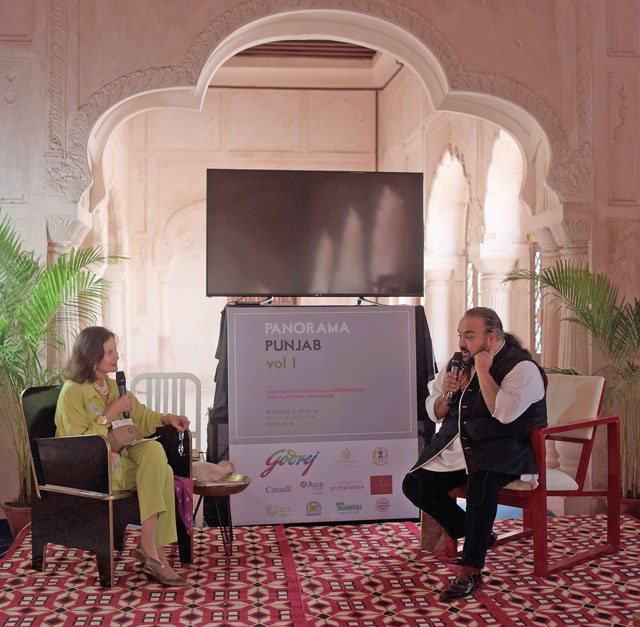
Fashion designer JJ Valaya being interviewed by Jill Spalding. Photograph: Patrick Sison.
Fashion was enlisted to provide a leitmotif of sorts by way of a spirited interview with the celebrity designer JJ Valaya (born Jagsharanjit Singh – no relation) whose House of Valaya, founded in 1993, helped to modernise India’s garment industry overnight with clothing adapted to new needs and desires. His revolutionary aesthetic, he imparted, evolved around glamour, and was principally powered by India’s booming wedding industry. Recalling Singh’s mission to repurpose the Fort from weddings to art, the interviewer asked the designer if he might take on the fuller role of conservationist and visionary – India’s Karl Lagerfeld – by preserving each region’s unique textile techniques and working them into truly revolutionary body coverings enabled by such advanced technologies as 3D-printed fused fibres. Valaya lit up. As with every event that preceded and followed, a seed had been planted.
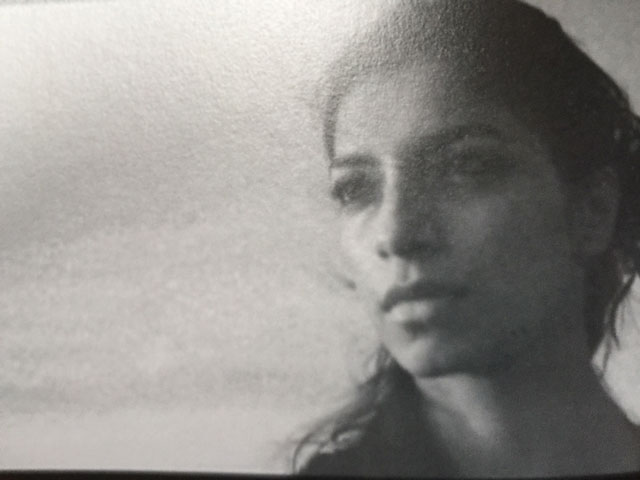
Sarah Singh. Secret Ships Series 1-4, 2013-15, video still.
There followed flights of music from the nationally renowned Jami Ensemble, five musicians working with the Indian tabla, the Afghan rubab, the Persian tombak, the Kashmiri Santoor and the Esraj to showcase the regional hybridity of instrumentation and composition from Iran to India. Scattered throughout looped a marking series of videos, all by women, which ranged from urgent to poetic across the full range of human sensibility. The one by Sarah Singh herself is a musing surrealist four-part series structured to reveal its protagonists’ inner turmoil through slow-motion fragments drawn from her celebrated film, A Million Rivers.
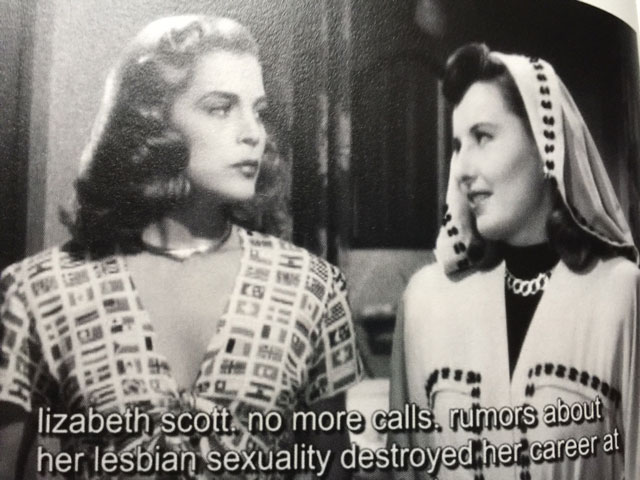
Debora Hirsch. FRAMED, 2009, video still.
Brazilian artist Debora Hirsch combines archival images of forgotten Hollywood starlets to comment on the burned-out hopes of faded careers. Hybrids (2014) by Swiss artist Olga Titus uses face paint and masks to signal an identity arrived at through the overlapping of various cultures. Cologne-based Gudrun Barenbrock’s large-scale multichannel collage overlays vintage VIH footage documenting the decline of the Ruhr area’s once-renowned steel and coal-mining industry with the artist’s recordings of rusting conveyor belts, collapsing infrastructure, and grinding trains spliced with images of razed mills and imploded architecture. Iran weighed in with Shirin Abedinirad’s Passage (2015), which engages light and water to explore the concept of death as a transition of body to spirit; Samira Eskandarfar’s A Dowry For Mahru – a frontal take on a local wedding she witnessed; and Bahar Behbahani’s satirical look at Turkey’s layered contradictions through the juxtaposition of ephemeral allusions to past and present. From the US, Meghan Boody Photoshopped a time-lapse of images manipulated in Trapcode and After Effects to reposition the male heroic quest as a young girl’s cosmic adventure into the kaleidoscope of a universal adulthood; Jeannie Weissglass looped 2D stop-motion animations in the order of the title – Lady Lion Tamer, Bee, Bat, Voyage, Twitch and Shout; and Carla Gannis created a new pictorial vocabulary from Bosch’s famous triptych with Garden of Emoji Delights (2014), tweaking the tiny pictographs to reframe hell as a tangled chaos unleashed by technology and societal disruption.
There was much more – poetry (India’s shared language), fencing (a state sport), a vigorous student play about the selfie culture, a Belgian jazz band quixotically committed to reviving bossa nova, and a moving tribute by India’s storied film-maker Sudhir Mishra to the revered actor and Patiala native son, Om Puri, whom we last saw in the west in The Hundred-Foot Journey (2014). Stirring up a debate about the “many Punjabs” and their future, a vivacious panel of best-selling Indian authors held forth under a shisham tree and its cacophony of crows, restrained only by the moderating skills of Karthika VK (of Harper Collins India, before she jumped the shark to Amazon’s Westland book division).
Holding court outside, in a just-restored section of the Fort’s interior, a speech-disabled performer, Shushil Kumar, wrote in water words shouted out by the audience, Masako Ono, a beautiful Japanese dancer accomplished in the Odissi dance tradition conveyed the ancient language of with movements so supple as to suggest an invertebrate. Casual onlookers coalesced into an audience as rapt and immovable as had they been seated in a theatre, with the exception of the children who ran up in wonder to stand in her aura. One such, possibly not yet three three years old, caught Singh’s attention. Ever the film-maker, she whipped out her camera to capture the moment, unable to contain her elation. Mission accomplished. That one child, she said later, by embracing this new glory had validated her travails. But would this superimposed paradise put down roots?
And those reviews? The first ones were positive. Put together by the unflappable Singh in so short a time, inaugurated with great gusto by the region’s mightiest officials and attended with equal excitement by high and low, the event has been deemed a brilliant cultural success. The only protagonist doubting its future was the ringmaster herself.
Much will depend on the support of political factions who conflate culture with privilege to protect their agendas. Sapping the triumph, like Punjab’s wealth-producing but not fully thought-out programme of rice agriculture that is leaching the water table and turning up arsenic in the fields, rival constituencies have been pitting Singh’s mission to promote the arts as a way out of poverty against a poor-starving-farmers agenda that will leave the current power structure exactly as is. A sticky wicket (the metaphor so apt in this cricket-obsessed state) if there ever was one.
It may be, Singh’s thinking now goes, that when the reviews are all in and should the consensus be cutting, the better way to go forward may be sideways. A steady stream – say, monthly – of less dazzling events that, nonetheless, will be geared towards opening the parochial mind to a wider horizon. Meanwhile, to fuel the irrepressible energy of this supremely talented artist-producer and pacesetter, various projects are up on the drawing board. First up? ALEXANDRA, an aesthetic work tracing Alexander the Great’s improbable 22,000-mile journey of conquest across mythic lands from Macedonia to Punjab, which Singh will convey through “experimental film and performance art rather than a BBC-type historic retelling”.
Don’t write off her ambition for Patiala, though. My bet is that before the end of the first quarter-century Singh will be the larger community’s household name.